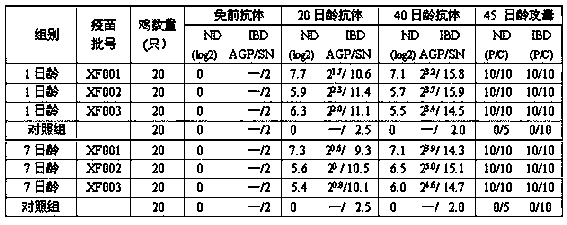Preparation method for newcastle disease and infectious bursal disease bigeminal composite inactivated vaccine
A technology for bursal disease and Newcastle disease, applied to medical preparations containing active ingredients, antiviral agents, pharmaceutical formulas, etc., can solve the problems of autoimmune system disorder, not widely promoted, high production costs, etc., to improve body fluid Immunity, improve the ability to prevent diseases, use safe and effective effect
- Summary
- Abstract
- Description
- Claims
- Application Information
AI Technical Summary
Problems solved by technology
Method used
Image
Examples
Embodiment 1
[0046] Example 1: Using DF-1 cell line to cultivate chicken infectious bursal virus to prepare chicken infectious bursal disease antigen solution
[0047] (1) Passage and culture of cells for seedling production: take chicken embryo fibroblast passage cell line DF-1 cell line, digest and passage with trypsin cell dispersion liquid, and continue to culture with cell growth liquid. When a good monolayer is formed, it is used to continue passaging or inoculation with virus;
[0048] (2) Propagation of cytotoxic seeds: take the infectious bursal virus HQ strain virus seeds for production, inoculate them in chicken embryo fibroblast passage cells that have grown into a good single layer according to 1% of the maintenance liquid volume, and place them at 37 Continue culturing in maintenance medium at ~38°C, and harvest the cell fluid when the cell lesion rate reaches 75% or more;
[0049] (3) Propagation of venom for seedling production: take the above-mentioned cell line culture f...
Embodiment 2
[0051] Example 2 Preparation of Chicken Newcastle Disease Antigen Solution Using Chicken Embryo Passage Cell Line and Bioreactor Culture
[0052] (1) Selection of bioreactor: Rapid flow reactor AP-20 with a volume of 7L.
[0053] (2) Selection of cells: chicken embryo cell line DF-1, a cell line suitable for the growth of chicken Newcastle disease virus, non-carcinogenic, purchased from the American Type Culture Collection;
[0054] (3) Selection of virus strains: the chicken Newcastle disease virus La sota strain was selected, which can be purchased from the China Veterinary Drug Control Institute.
[0055] (4) Cultivation of different cells: DF-1 cells are cultured in a square bottle, generally passaged at a ratio of 1:3 to 1:5, digested and counted after the cells have grown to a single layer, and used for large-scale cell culture.
[0056] (5) Propagation of cell-adapted virus species: take the cell-adapted Newcastle disease virus virus species, inoculate it into the pass...
Embodiment 3
[0061] Embodiment 3 Preparation of Chinese medicine polysaccharides and Chinese medicine flavonoids
[0062] a. Weigh 20 parts of Achyranthes bidentata, 15 parts of Poria cocos, 25 parts of Andrographis paniculata, 30 parts of Astragalus membranaceus, 20 parts of Banlangen, 20 parts of raw land, 20 parts of angelica, 15 parts of licorice and 20 parts of rhubarb, chop and wash Then soak in cold water overnight, then add purified water 15 times the weight of the raw material, take a water bath to 90°C, and keep it at 90°C, cook for 2 hours, and stir every 10 minutes during the cooking process;
[0063] b. Discard the dregs of the traditional Chinese medicine in a, collect the medicinal liquid, and centrifuge at 10,000 rpm for 10 minutes after cooling at room temperature, discard the precipitate, and collect the supernatant;
[0064] c. The supernatant in b is subjected to alcohol precipitation, the precipitation is the crude Chinese medicine polysaccharide, and the supernatant i...
PUM
 Login to View More
Login to View More Abstract
Description
Claims
Application Information
 Login to View More
Login to View More - R&D
- Intellectual Property
- Life Sciences
- Materials
- Tech Scout
- Unparalleled Data Quality
- Higher Quality Content
- 60% Fewer Hallucinations
Browse by: Latest US Patents, China's latest patents, Technical Efficacy Thesaurus, Application Domain, Technology Topic, Popular Technical Reports.
© 2025 PatSnap. All rights reserved.Legal|Privacy policy|Modern Slavery Act Transparency Statement|Sitemap|About US| Contact US: help@patsnap.com



